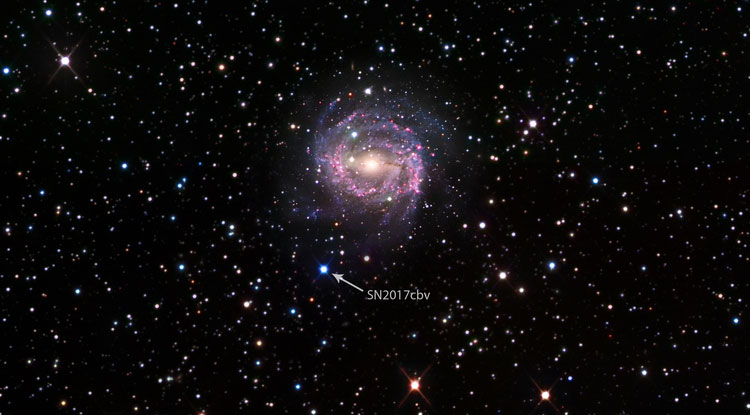The supernova explosion is 55 million light-years from Earth
Scientists use an automated telescope network to observe details of a supernova explosion 55 million light-years from Earth.
David Sand at the University of Arizona, USA, received a notification from the PROMPT telescope in Chile about the SN 2017cbv supernova explosion at one of the 500 galaxies it is tracking on March 10, according to IFL Science. This supernova explosion occurred in NGC 5643 , a spiral galaxy 55 million light-years from Earth. Observations were made in the August 14 issue of the Astrophysical Journal Letters.

Supernova explosion SN 2017cbv is 55 million light-years from Earth.(Photo: Space).
Supernova explosions can be as bright as the whole galaxy. Automated telescope surveys are a useful tool to detect them. Thanks to PROMPT's observation of a new bright spot, Sand uses the 18 global robot telescopes network of the Las Cumbres Observatory (LCOGT) of the University of California, USA, to continuously monitor the explosion.
"In a galaxy like our Milky Way, the supernova explosion averages about once in a century. We are very lucky to see this phenomenon," Sand said.
SN 2017cbv, a supernova of type Ia, occurs when a white dwarf draws away matter from a companion star in a binary star system until it reaches a sufficiently large mass and explodes. By studying the early phase of SN 2017cbv supernova, the team was able to see the material emitted by a dying star as it collided with the companion star.
"We are looking at the phenomenon of a supernova colliding with its companion star as predicted in 2010. We have collected many important data before, and this observation is Undeniable evidence, "said Griffin Hosseinzadeh, a member of the research team.
In astronomy, supernova explosions are often used as cosmic measures because most of them have similar brightness. Based on the blur of the supernova explosion, we can estimate the distance to them.
- The supernova explosion is 10.5 billion light-years away from Earth
- Earth used to catch supernova dust
- Build 3D core map of a supernova
- The supernova explosion can destroy Earth from 50 light years
- The light of the supernova explosion SN 1987A continued to shine
- Supernovae can cause extinction 2.5 million years ago
- Create supernova explosions in the laboratory
- Core Earth originated from supernova?
- Direct observation of a new bright star explosion
- The lonely death of a star
- Life evolved through an explosion on earth
- NASA first recorded a giant red star explosion
 Van Allen's belt and evidence that the Apollo 11 mission to the Moon was myth
Van Allen's belt and evidence that the Apollo 11 mission to the Moon was myth The levels of civilization in the universe (Kardashev scale)
The levels of civilization in the universe (Kardashev scale) Today Mars, the sun and the Earth are aligned
Today Mars, the sun and the Earth are aligned The Amazon owner announced a secret plan to build a space base for thousands of people
The Amazon owner announced a secret plan to build a space base for thousands of people